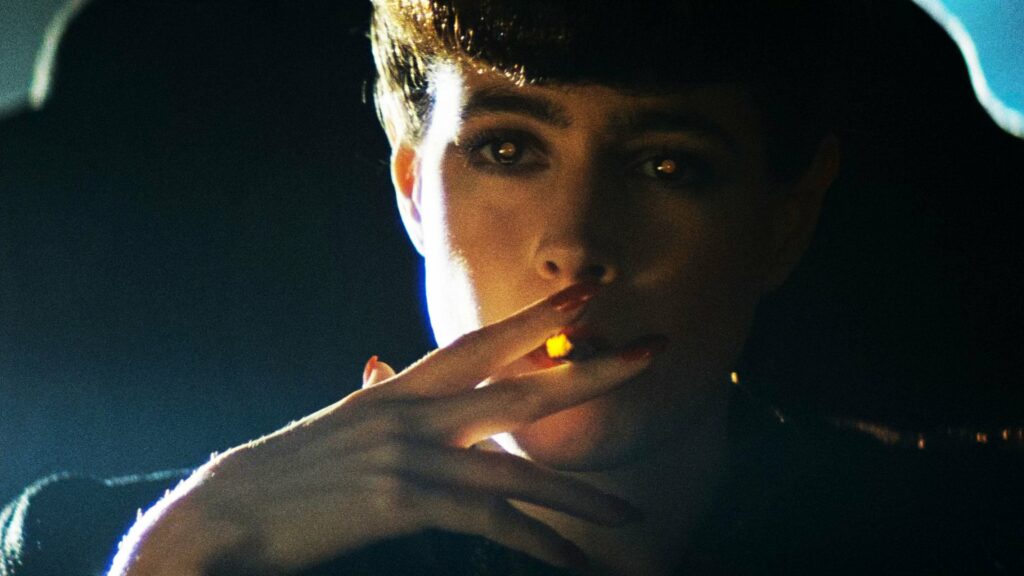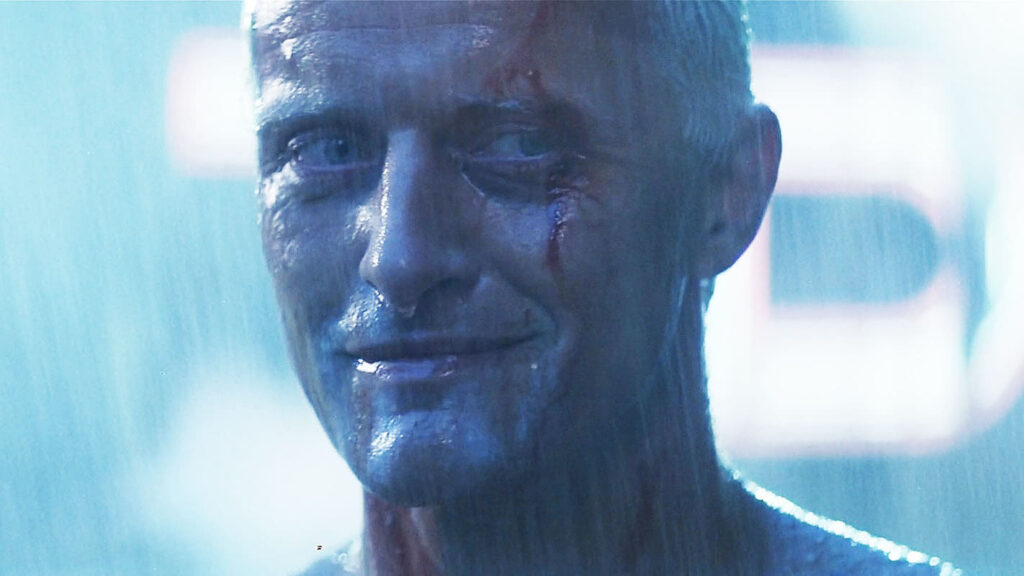I've seen things you people wouldn't believe...
Blade Runner has some of the greatest production and set design in movie history. I don’t really think this is even debatable. Every set is a mini-masterpiece of design: Deckard’s cluttered apartment, filled with old-timey photographs and trinkets; the rainy streets, crowded with people and aliens and cyborgs, rendered with the terror of an agoraphobe who has only read about “cities” in books; the gleaming Tyrell HQ, a frightening monument of grotesque, angular luxury; and, perhaps greatest of all, the setting of the apocalyptic finale, the expressionistic rooftop skyline, a jagged stalagmite ridge that serves as an unholy space cathedral, part Victor Hugo and part HP Lovecraft.
This incredible visual design is executed by world-class creative talent delivering all-time great work: Director Ridley Scott crafts a methodical, slightly surreal film texture. Cinematographer Jordan Cronenworth fuses a contradictory set of ideas — neon-curdled blackness that’s sometimes claustrophobic and sometimes an abyss — into a style often imitated but wholly unique. Production designer Lawrence Paull and art director David Snyder bring some classicism, some futurism, and a million visual ideas that are a bit of both.
This results in Blade Runner being a specimen of a certain kind of overwhelming worldbuilding — the kind where you feel plopped in the middle of a world so much bigger and busier and more complicated than our story that it makes the characters and the scenario we follow feel like tiny specks of dust. It’s astoundingly great and influential science fiction, the kind that rekindles a curiosity about what the future might mean for the soul of mankind. Blade Runner is one of the canonical cyberpunk texts of any medium: equal parts dystopian tech-tastrophe and criminal underworld.

What is miraculous about the film is how the genius of the visuals and world construction enhance everything around it. The story, a messy and barely coherent noir about an android hunter, grows so much bigger and more profound in its execution. What could have been pulpy and quirky becomes a postmodern query on the relationship between God and man, between objective natural truths and manipulated false realities, between fate and free will. It’s a phenomenal class commentary on the way the one-percent exploits and dehumanizes the working class, but this is also only, like, the fourth-most important thematic concern of Blade Runner.
The score by Vangelis is nearly as flavorful and great as the visuals are. It’s an ambient masterpiece, a hazy urban-noir soundscape and filtered through a retro-futuristic proto-EDM texture. There are hints of Eastern music lurking in the themes. Its tone is chilly and metallic except for Rachael’s romantic theme, evoking a Hollywood film scores as if they are a long-distant memory refracted through dystopian pessimism.
The story, adapted from a Philip K. Dick novel, is set in 2019 Los Angeles, back when 2019 was the distant future. Humans have manufactured androids virtually indistinguishable from humans called “replicants.” They’re owned by the lucky few who can afford the artificial humans, doing slave labor and fulfilling whatever dark whims the uber-wealthy have, so the billionaires can sit around with their heads in the clouds. (And so, the film ponders as subtext, who really is more human? Artificial life doing day-to-day human things, or real humans who are disengaged with basic reality?)

The line between replicant and human has grown even blurrier with the release of sixth model of the technology, which is virtually indistinguishable from naturally-occurring homo sapiens. The Nexus 6 has intelligence, memory, distinct personality, and the ability to collaborate with its peers. It also has superhuman strength, agility, and resilience. Whether they have a soul or a conscience is a major topic of thematic inspection of the film. These androids have been programmed with a four-year lifespan — in part so they aren’t able to unite and rebel. Ironically, this is the very cause of their rebellion — they hunt down their creator, Eldon Tyrell (Joe Turkel), to try and cure their mortality. To quote the chief replicant, Roy Batty (Rutger Hauer): “I want more life, fucker!”
As if the Nexus 6 models aren’t dangerous enough, Tyrell has a new experiment up his sleeves. We meet Rachael (Sean Young), a prototype of a next-generation replicant that is implanted with memories from before their creation so that they can have more human context for their actions and make better decisions. She has so much human context, in fact, that she’s not even aware she is a replicant. “Human context” morphs into “free will” and “self-identity.”
We follow Rick Deckard (Harrison Ford), an ex-cop who is hunting down the remaining Nexus-6 replicants. As Deckard closes in on them one at a time, he starts falling in love with Rachael, with whom he shares an instant connection. What starts as a routine cops-and-robbers, cat-and-mouse chase story grows more existentially charged with each passing scene as the number of replicants shrinks more and more, their very “species” at risk of extinction.
Clearly inspired by the great, messy hardboiled detective stories of the ’40s and ’50s, Scott shows little interest in a rich or coherent narrative. He’s more concerned with texture and thematic heft, and these are of course so good that they draw you in as much as a plottier script would have.
Blade Runner climaxes with a set piece so astonishingly great that it absolves the film of the idiosyncrasies leading up to it. It is a chase through a cluttered building and rainy rooftop between Deckard and Roy that pays off on just about everything leading up to it. It ends up being more about Roy than Deckard — how will the artificial human face his oblivion — with peace or wrath? The outcome is such a lovely piece of sci-fi writing, it has its own Wikipedia page.

Part of the reason the movie’s twists have so much punch is because the characters are so well-defined by their actors. Ford is excellent as expected, a more introspective version of the rugged hero he gave us in Indiana Jones and Han Solo. Even better is Hauer as the villain Roy, turning a self-aware android into a Shakespearean figure who physically domineers Ford in the climax. Hauer unites the weird ideas shaping the character into something distinct and flavorful. It had me looking up his filmography, wondering why I haven’t seen him in more stuff. (It turns out that I have, but mostly in small, glory years supporting roles throughout the 2000s.) Overall, it’s a great and well-rounded ensemble, filled with lots of little scene-stealing turns by great character actors.
The question underlying Blade Runner that viewers have been debating since the movie premiered is whether Deckard himself is a replicant with memories implanted, just like Rachael. The most popular take is that Deckard is indeed a replicant. There are plenty of hints for such a reading: A recurring police officer, Gaff (Edward James Olmos), seems to know details of Deckard’s visions and psychology that would only be possible if his memories had been implanted. Several characters treat Deckard as if they know he is a replicant, and both Rachael and Roy exhibit some innate connection to him, perhaps detecting a sameness.
And yet there are some reasons to doubt this claim: Deckard is physically outclassed by the other replicants, and there’s really no reason given for why a replicant would be responsible for hunting down others. There’s also the matter of audience expectation: we assume our proxy in the film is like us, and the hints that he is a replicant can just as well be read as thematic contrast rather than a direct statement about Deckard’s true nature: How different, really, is a person crafted by God from a person crafted by man?
(I’ve never seen it, but apparently, the original theatrical cut trims out some of the material supporting the idea of Deckard being a replicant and adds a voiceover that fans almost universally despise. You can watch the voiced sections on YouTube: it turns him into a more stereotypical human ex-cop . Everyone I’ve queried recommends either the 1992 Director’s Cut or 2007 Final Cut, which are similar in content, though the latter has some polished visuals. I watched the Final Cut for this review.)

In a run-of-the-mill good movie, this key question — is Deckard man or machine — would be a fun piece of puzzle box ambiguity, perhaps akin to the spinning top that closes Inception: a conundrum that forces us to question some basic assumptions about what we just saw. But it runs even deeper in Blade Runner, resulting in perhaps the single most fascinating thought exercise one can engage in with sci fi cinema. The matter of Deckard’s personhood is not just a question, it’s the question, and its unknowability is the point: In a world where our soul is stripped away by machinery and institutions more and more each day, the very things that make us human crumble away. How can we function when when that is in doubt? How can our life have meaning when the crushing oppression of modernity ensures that we will all be lost in time, like tears in rain? What would a Voight-Kampff test on ourselves reveal?
For Roy Batty, the solution is to hunt down his maker. For Deckard, the answer is unclear. But one thing is clear about Deckard’s identity crisis and Blade Runner in general: Whether your creator is a god in the sky or a man in a tower, we are all shackled to our earthly mortality. True freedom is taking that mundanity and limitation, and crafting it into something beautiful and something from your own vision, like plain paper folded into origami. In a world as frightening as 2019 LA — as frightening as our own — to do so is as rare and beautiful as a unicorn.
Is It Good?
Masterpiece: Tour De Good (8/8)
Follow Dan on Letterboxd or Twitter. Join the Discord for updates and discussion.


8 replies on “Blade Runner (1982)”
My favourite English-language film. Things were gonna get ugly around here if I scrolled down and saw anything lower than a 7!
And here I had been pinging Gavin with my BR questions. Should have been you, too! I didn’t remember it was so high on your Top 100.
If you want some peak Hauer, you have options, but the first thing that came to mind was The Hitcher.
He’s easily the best thing in Ladyhawke. And if you don’t mind some sordid content, he’s amazing in Flesh + Blood.
I have no particular attachment to BLADE RUNNER – dystopia is something I become
less and less patient with by the year – but it unquestionably grabs a viewer.
On a less serious note, I admit to being a little amused to learn that you have little previous experience of the late, Great Rutger Hauer (For reasons that should be quite clear, given I refer to him as one of the Greats).
Clearly we have been watching quite different films for most of our lives, for once you look for him the man was EVERYWHERE (and moviegoers & film lovers owe him thanks for it).
(-:
Dang it, I forgot to add a smiley face – one meant to be gently teasing, not supercilious!
I’ve seen him in four movies: this, Batman Begins, Sin City, and Confessions of a Dangerous Mind. I never placed them as being the same actor until I looked up his credits after watching this. I’ll definitely be keeping my eye out for him in the future
It may amuse you to know that, in addition to all these other claims to Geek Chic, Mr Hauer also played the villain in BUFFY THE VAMPIRE SLAYER – the AD 1992 Film that represents a sort of rough draft for the series.